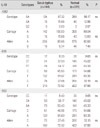Abstract
Background
Scrub typhus is caused by Orientia tsutsugamushi and can become severe and potentially life-threatening. It is suggested that specific host factors can modify the host response during O. tsutsugamushi infection. It is known that susceptibility and outcome of infectious disease are associated with genetic polymorphisms of some cytokines.
Materials and Methods
Peripheral blood of 144 patients who were diagnosed with scrub typhus and of 311 unrelated healthy subjects were collected. A diagnosis of scrub typhus was made upon demonstration of a fourfold rise in antibody titer to O. tsutsugamushi in paired serum specimens in an indirect immunofluorescent (IFA) test. Genomic DNAs were extracted from peripheral mononuclear cells and genotypings for IL-1 (-511C/T), IL-1β (+3953T/C), IL-2 (-330T/G), IL-4 (-590C/T), IL-4R(-1902G/A), IL-10 (-1082G/A), IL-10 (-819C/T), TNF-α (-238G/A) and TNF-α (-308G/A) were performed simultaneously using PCR-SSP (sequence specific polymorphisms) assay.
Results
The frequency of IL-1 (-511T/T) (OR=0.53, P<0.01) and IL-2 (-330T/T) (OR=0.56, P<0.01) were significantly decreased, but that of IL-2(-330G/G) (OR=4.49, P<0.01) was increased, in the scrub typhus patients compared to the healthy controls. And, there were no statistically significant differences in the genetic polymorphisms of IL-4 (-590C/T), IL-4Rα (-1902G/A), IL-10 (-1082G/A), IL-10 (-819C/T), TNF-α (-238G/A), TNF-α (-308G/A) genes, in the scrub typhus patients compared to the unrelated healthy controls.
Figures and Tables
Figure 1
Results of PCR-SSP (Sequence specific polymorphism) for Cytokine Polymorphisms. M, indicate DNA size marker; internal control, 440 bp.

Table 2
Comparison of the IL-1β-511, IL-1β+3953 Polymorphism between Scrub Typhus Patients and Normal Controls in Korean Population

Table 3
Comparison of the IL-2-330 Polymorphism between Scrub Typhus Patients and Normal Controls in Korean Population

Table 4
Comparison of the IL-4-590 and IL-4Rα-1902 Polymorphism between Scrub Typhus Patients and Normal Controls in Korean Population

References
1. Seong SY, Choi MS, Kim IS. Orientia tsutsugamushi infection: overview and immune response. Microbes Infect. 2001. 3:11–21.
2. Iwasaki H, Takada N, Nakamura T, Ueda T. Increased levels of macrophage colony-stimulating factor, gamma interferon, and tumor necrosis factor alpha in sera of patients with Orientia tsutsugamushi infection. J Clin Microbiol. 1997. 35:3320–3322.

5. Holmes CL, Russell JA, Walley KR. Genetic polymorphism in sepsis and septic shock: role in prognosis and potential for therapy. Chest. 2003. 124:1103–1115.
6. Shin HD, Park BL, Kim YH, Cheong HS, Lee IH, Park SK. Common interleukin 10 polymorphisms associated with decreased risk of tuberculosis. Exp Mol Med. 2005. 37:128–132.

7. Wilson J, Rowlands K, Rockett K, Moore C, Lockhart E, Sharland M, Kwiatkowski D, Hull J. Genetic variation at the IL 10 gene locus is associated with severity of respiratory syncytial virus bronchiolitis. J Infect Dis. 2005. 191:1705–1709.

8. Sallakci N, Akcurin G, Köksoy S, Kardelen F, Uguz A, Coskun M, Ertug H, Yegin O. TNF-alpha G-308A polymorphism is associated with rheumatic fever and correlates with increased TNF-alpha production. J Autoimmun. 2005. 25:150–154.

9. O'Keefe GE, Hybki DL, Munford RS. The G-->A single nucleotide polymorphism at the -308 position in the tumor necrosis factor-alpha promoter increases the risk for severe sepsis after trauma. J Trauma. 2002. 52:817–825.
11. Herrmann JL, Blanchard H, Brunengo P, Lagrange PH. TNF alpha, IL-1 beta and IL-6 plasma levels in neutropenic patients after onset of fever and correlation with the C-reactive protein(CRP) kinetic values. Infection. 1994. 22:309–315.

12. Engel A, Kern WV, Mürdter G, Kern P. Kinetics and correlation with body temperature of circulating interleukin-6, interleukin-8, tumor necrosis factor alpha and interleukin-1 beta in patients with fever and neutropenia. Infection. 1994. 22:160–164.

13. Schaaf BM, Boehmke F, Esnaashari H, Seitzer U, Kothe H, Maass M, Zabel P, Dalhoff K. Pneumococcal septic shock is associated with the interleukin-10-1082 gene promoter polymorphism. Am J Respir Crit Care Med. 2003. 168:476–480.

14. Smolnikova MV, Konenkov VI. Association of IL2, TNFA, IL4 and IL10 promoter gene polymorphisms with the rate of progression of the HIV infection. Russ J Immunol. 2002. 7:349–356.
15. Iwasaki H, Mahara F, Takada N, Fujita H, Ueda T. Fulminant Japanese spotted fever associated with hypercytokinemia. J Clin Microbiol. 2001. 39:2341–2343.

16. Hulkkonen J, Laippala P, Hurme M. A rare allele combination of the interleukin-1 gene complex is associated with high interleukin-1 beta plasma levels in healthy individuals. Eur Cytokine Netw. 2000. 11:251–255.




 PDF
PDF ePub
ePub Citation
Citation Print
Print





 XML Download
XML Download